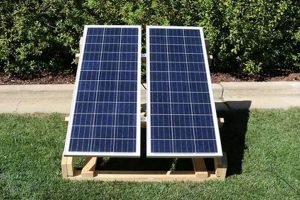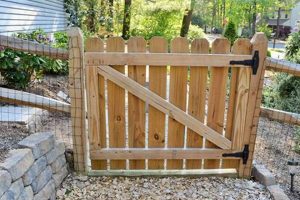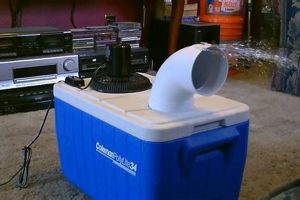A self-assembled media storage unit provides a customized solution for organizing televisions, audio equipment, and associated accessories. Constructed from materials readily available at home improvement stores, or repurposed from existing furniture, such a unit allows for tailored dimensions and aesthetic choices to complement a specific living space. Examples range from simple shelving constructed from reclaimed wood to more elaborate designs incorporating drawers, cabinets, and integrated lighting.
The significance of such a project lies in its potential to reduce costs compared to purchasing pre-fabricated furniture, offer greater design flexibility, and provide a sense of accomplishment for the builder. Historically, crafting furniture at home was commonplace. The advent of mass production shifted consumer behavior. Now, a renewed interest in handmade goods and personalized spaces has driven the resurgence of this approach. This activity promotes resourcefulness and reduces reliance on mass-produced items, aligning with sustainability principles.
The subsequent sections will delve into the planning stages, material selection, construction techniques, and finishing options relevant to successfully creating a personalized and functional media storage solution.
Considerations for Self-Assembled Media Storage Solutions
The following outlines key aspects to consider when undertaking the construction of personalized media storage.
Tip 1: Assess Spatial Dimensions. Accurately measure the intended location. Account for existing architectural features like baseboards, outlets, and window placements that may impede installation. The measurements should accommodate the electronic components and the space required for cable management.
Tip 2: Define Functional Requirements. Determine the specific storage requirements. Calculate the number of shelves, drawers, or cabinets needed. Consider the weight capacity necessary to support the intended devices, such as televisions, sound systems, and gaming consoles.
Tip 3: Select Appropriate Materials. Choose materials based on aesthetic preferences, budget constraints, and structural integrity. Options include solid wood, plywood, MDF (Medium-Density Fiberboard), and metal. Solid wood offers durability and a premium appearance, while MDF provides a smooth surface for painting.
Tip 4: Plan for Cable Management. Integrate a systematic approach to cable management. Designate specific areas for routing cables, including strategically placed holes or channels. Implement cable ties or sleeves to maintain organization and prevent entanglement.
Tip 5: Prioritize Structural Stability. Employ appropriate joinery techniques to ensure structural soundness. Screws, dowels, and wood glue provide effective fastening methods. Consider the use of corner braces or reinforcements for added stability, especially for larger units.
Tip 6: Incorporate Ventilation. Integrate ventilation into the design, particularly if enclosed compartments are planned. This prevents heat buildup from electronic components, potentially prolonging their lifespan. Use ventilation holes or open-backed shelves to facilitate airflow.
Tip 7: Apply a Protective Finish. Apply a protective finish to enhance durability and aesthetic appeal. Options include paint, stain, varnish, or polyurethane. Ensure the finish is compatible with the chosen material and is applied according to the manufacturer’s instructions.
These considerations are crucial for a functional, aesthetically pleasing, and enduring media storage solution, tailored to individual requirements and spatial characteristics.
With these tips in mind, one can ensure the finished result is as effective as it is attractive.
1. Dimensions
The dimensional aspect is a critical determinant of success in any self-assembled media storage unit project. Accurate measurements of the intended location are paramount. A failure to account for existing architectural features, such as baseboards or outlets, will inevitably lead to installation difficulties. The internal dimensions must accommodate all intended electronic components, with sufficient clearance for ventilation and cable access. An undersized shelf will not support a television, while an oversized unit may overwhelm the room. For instance, a media unit designed for a small apartment might be shallower and taller to maximize vertical space, while a unit for a larger living room could extend horizontally.
Beyond simply fitting within the available space, appropriate dimensions contribute to the overall ergonomics and visual appeal of the unit. Shelf heights should be considered relative to the user’s viewing angle. Incorporating varying shelf depths can add visual interest and accommodate items of different sizes. Accurate dimensional planning also informs material selection. Larger spans may require thicker, more robust materials to prevent sagging or bowing under load. Precisely dimensioned cut lists are essential for efficient material utilization and minimization of waste, directly impacting project costs.
In summary, the careful consideration and accurate execution of dimensional specifications are fundamental to achieving a functional and aesthetically pleasing self-assembled media storage unit. Neglecting this stage increases the likelihood of design flaws, installation challenges, and ultimately, an unsatisfactory result. A meticulously planned dimensional layout forms the foundation for a successful project, ensuring it seamlessly integrates into the intended environment and fulfills its intended purpose.
2. Materials
Material selection forms a cornerstone of any self-assembled media storage unit project, directly influencing its aesthetic, durability, and cost. The chosen materials dictate the structural integrity, visual appeal, and longevity of the final product. Careful consideration must be given to the properties and characteristics of various options.
- Solid Wood
Solid wood provides inherent strength and a natural aesthetic. Hardwoods like oak, maple, and cherry offer superior durability and resistance to wear and tear. Softwoods, such as pine and fir, are more economical but may require additional surface protection. For example, a unit constructed from oak provides a robust platform for heavy electronics and resists scratching, while a pine unit may be better suited for lighter loads and requires a protective finish to prevent denting. The selection of solid wood also allows for varied joinery techniques, contributing to the overall structural integrity and visual appeal.
- Plywood
Plywood offers a cost-effective alternative to solid wood, providing a stable and versatile material. Its layered construction minimizes warping and splitting, making it suitable for large panels and shelves. Different grades of plywood offer varying levels o
f smoothness and surface quality. For instance, Baltic birch plywood is prized for its void-free core and smooth face, making it ideal for projects requiring a high-quality finish. Lower grades of plywood may exhibit imperfections and require more extensive preparation before painting or staining. The use of plywood allows for efficient material utilization and consistent dimensions, simplifying the construction process. - Medium-Density Fiberboard (MDF)
MDF is an engineered wood product composed of wood fibers bonded together with resin. It provides a smooth, consistent surface that is ideal for painting and veneering. MDF is less susceptible to expansion and contraction than solid wood, making it a stable choice for painted projects. However, MDF is less resistant to moisture and impacts than solid wood or plywood. A media unit constructed from MDF requires careful sealing and a durable finish to protect it from damage. The ease of machining and shaping MDF makes it suitable for intricate designs and detailed moldings.
- Metal
Metal, such as steel or aluminum, can be incorporated into the design for structural support or aesthetic accents. Steel provides exceptional strength and rigidity, making it suitable for load-bearing components. Aluminum is lightweight and corrosion-resistant, making it ideal for decorative elements. Metal can be powder-coated or painted to provide a durable and visually appealing finish. A media unit incorporating a steel frame offers superior stability and allows for open shelving designs. The use of metal adds an industrial aesthetic and provides a durable and long-lasting solution.
The selection of appropriate materials is paramount to the success of any self-assembled media storage project. Each material offers distinct advantages and disadvantages that must be carefully weighed against the project’s specific requirements, budget constraints, and desired aesthetic. A thorough understanding of the properties and characteristics of various materials allows for informed decision-making and the creation of a functional, durable, and visually appealing media storage solution tailored to individual needs.
3. Layout
Layout, in the context of a self-assembled media storage unit, transcends mere spatial arrangement. It represents a fundamental design consideration directly impacting functionality, aesthetics, and integration with the surrounding environment. A well-conceived layout optimizes storage capacity, facilitates seamless cable management, and enhances the viewing experience.
- Component Placement and Accessibility
Strategic placement of components is crucial for usability. Devices frequently accessed, such as gaming consoles or Blu-ray players, should be positioned within easy reach. Conversely, less frequently used components can be located in less accessible areas. Example: A sound system’s amplifier might be placed on a lower shelf with ample ventilation, while streaming devices are located closer to the television. Logical component placement minimizes strain and enhances the user experience.
- Storage Capacity and Organization
Effective layouts maximize storage potential. Shelves, drawers, and cabinets provide designated spaces for media, accessories, and other items. Modular designs offer flexibility to adapt to changing storage needs. Example: Incorporating adjustable shelves allows for customization to accommodate various media formats. Proper organization minimizes clutter and enhances the overall aesthetic appeal.
- Cable Management Integration
A functional layout incorporates provisions for effective cable management. Routing channels, access holes, and concealed compartments prevent tangled wires and maintain a clean appearance. Example: Designing a rear panel with grommets for cable pass-through minimizes visual clutter. Organized cabling enhances airflow and simplifies troubleshooting.
- Aesthetic Harmony and Visual Balance
The layout contributes significantly to the overall visual aesthetic. Balanced proportions, symmetrical arrangements, and complementary design elements create a harmonious appearance. Example: A centered television with flanking shelves or cabinets creates visual balance. A well-designed layout enhances the surrounding environment and complements existing decor.
These layout considerations represent integral aspects of any successful self-assembled media storage unit project. Failure to adequately address these elements can result in a functional but visually unappealing, or an aesthetically pleasing but impractical outcome. A holistic approach to layout design ensures the creation of a media storage solution that is both functional and visually harmonious.
4. Joinery
Joinery, the art and technique of connecting pieces of wood or other materials, represents a critical element in the construction of a self-assembled media storage unit. The selection and execution of appropriate joinery methods directly impact the structural integrity, longevity, and aesthetic appeal of the final product. Understanding various joinery techniques and their suitability for specific applications is essential for a successful project.
- Butt Joints and Screw Fastening
Butt joints, the simplest form of joinery, involve abutting two pieces of material end-to-end or edge-to-edge. Reinforcement is typically achieved through screws, nails, or adhesive. While easy to execute, butt joints are inherently weak and rely heavily on the strength of the fasteners. In a self-assembled media storage unit, butt joints may be suitable for non-load-bearing components, such as attaching a thin back panel to a cabinet. However, for structural components like shelves or frame members, alternative joinery methods are preferable due to the risk of joint failure under stress.
- Dowel Joints
Dowel joints enhance the strength of butt joints by inserting cylindrical dowels into precisely drilled holes in both joining pieces. Dowels increase the surface area for adhesive bonding and provide mechanical interlock. Dowel joints offer a balance of strength and ease of execution, making them suitable for assembling shelves or frames in a media storage unit. Accurate drilling is crucial for proper alignment and joint integrity. Jig systems are available to ensure consistent hole placement, enhancing the precision and reliability of dowel joints.
- Dado Joints
Dado joints involve cutting a groove (dado) into one piece of material and inserting the edge of another piece into the groove. Dado joints provide substantial strength and stability, particularly when combined with adhesive. They are well-suited for constructing shelves and partitions in a media storage unit, preventing sagging and ensuring squareness. Accurate cutting of the dado is essential for a tight-fitting joint. A router or table saw can be used to create precise dados. The depth and width of the dado should be carefully matched to the thickness of the joining piece.
- Mortise and Tenon Joints
Mortise and tenon joints are among the strongest and most traditional forms of joinery. A mortise (hole) is cut into one piece of material, and a tenon (projection) is formed on the end of another piece. The tenon is then inserted into the mortise, creating a mechanical interlock. Mortise and t
enon joints offer exceptional strength and resistance to racking forces, making them ideal for constructing the frame of a media storage unit. While more complex to execute than other joinery methods, mortise and tenon joints provide superior durability and a refined aesthetic. Variations include through tenons, blind tenons, and wedged tenons, each offering unique advantages.
The selection of appropriate joinery techniques directly influences the structural integrity and longevity of a self-assembled media storage unit. While simple joinery methods like butt joints may suffice for non-structural components, stronger joints such as dadoes, dowels, or mortise and tenons are crucial for load-bearing elements. A well-executed joinery strategy ensures a robust and durable media storage solution that can withstand the stresses of everyday use.
5. Finishing
Finishing, in the context of a self-assembled media storage unit, is not merely an aesthetic consideration, but rather a critical process influencing durability, longevity, and overall functionality. The application of appropriate finishing techniques protects the underlying material from environmental factors, enhances its visual appeal, and contributes to the long-term value of the project.
- Surface Preparation
Proper surface preparation is paramount to achieving a satisfactory finish. Sanding, filling imperfections, and cleaning the surface are essential steps prior to the application of any finish. For example, failing to adequately sand a wooden surface will result in uneven stain absorption and a textured finish. Surface preparation ensures proper adhesion and a uniform appearance. Neglecting this stage compromises the quality and longevity of the final finish.
- Protective Coatings
Protective coatings shield the media storage unit from moisture, scratches, and UV damage. Options include varnishes, lacquers, and polyurethanes. These coatings form a durable barrier that prevents wear and tear, extending the lifespan of the unit. Example: A polyurethane finish on a wooden media unit provides resistance to spills and scratches, maintaining its appearance over time. The selection of an appropriate protective coating depends on the intended use and environmental conditions.
- Aesthetic Enhancement
Finishing techniques enhance the aesthetic appeal of the media storage unit, allowing for customization to match existing decor. Staining, painting, and applying decorative finishes can transform the appearance of the unit. Example: A stained media unit showcases the natural grain of the wood, while a painted unit offers a wider range of color options. The selection of aesthetic finishes is a matter of personal preference and design considerations.
- Edge Finishing and Detailing
Careful attention to edge finishing and detailing contributes to a professional and refined appearance. Applying edge banding, rounding sharp edges, and adding decorative moldings enhance the overall aesthetic. Example: Applying iron-on edge banding to plywood edges conceals the exposed plies and creates a smooth, finished look. These details elevate the appearance of the unit and demonstrate craftsmanship.
The selection and application of appropriate finishing techniques are integral to the success of a self-assembled media storage unit project. From surface preparation to the application of protective coatings and aesthetic enhancements, each step contributes to the durability, longevity, and visual appeal of the final product. A well-executed finish not only protects the unit from damage but also transforms it into a visually appealing and functional addition to the living space.
6. Cabling
Effective cable management is a fundamental aspect of any self-assembled media storage unit project. A well-organized cabling system not only enhances the aesthetic appeal of the unit but also contributes to its functionality and longevity. Improper cable management can lead to tangled wires, reduced airflow, and potential damage to electronic components.
- Cable Routing Channels
Integrated cable routing channels provide a dedicated pathway for cables to travel from one component to another, minimizing clutter and preventing tangling. These channels can be incorporated into the design of the unit using various materials, such as PVC pipes or metal conduits. Example: A channel running along the back of the unit allows cables to be neatly routed from the television to the sound system, concealing them from view. The implementation of routing channels simplifies cable management and improves the overall aesthetic of the unit.
- Access Holes and Grommets
Strategic placement of access holes allows cables to pass through shelves and partitions, maintaining a clean and organized appearance. Grommets, inserted into these holes, protect cables from abrasion and prevent damage. Example: Access holes drilled through the back of shelves allow cables to connect components on different levels of the media unit, while grommets prevent the sharp edges of the holes from damaging the cable insulation. The utilization of access holes and grommets promotes efficient cable management and enhances the safety of the wiring.
- Cable Ties and Sleeves
Cable ties and sleeves are used to bundle and organize cables, preventing them from becoming tangled and creating a visual mess. Cable ties secure groups of cables together, while sleeves encase multiple cables in a protective sheath. Example: Cable ties can be used to bundle the power cords for various electronic devices, keeping them neatly organized behind the unit. Sleeves can encase all of the cables connecting the television to the sound system, creating a clean and streamlined appearance. These accessories simplify cable management and improve the overall aesthetic of the unit.
- Power Management and Surge Protection
Integrating power management solutions, such as power strips with surge protection, protects electronic components from voltage fluctuations and power surges. These devices provide a centralized location for powering multiple devices and offer protection against electrical damage. Example: A power strip with surge protection, concealed within a cabinet of the media unit, provides a safe and convenient way to power all of the electronic components. The incorporation of power management solutions ensures the safety and longevity of the electronic equipment housed within the unit.
The implementation of effective cable management techniques is essential for creating a functional and aesthetically pleasing self-assembled media storage unit. From integrated routing channels to power management solutions, a well-designed cabling system contributes significantly to the overall value and usability of the unit. The careful consideration of cabling during the design and construction phases ensures a clean, organized, and safe media storage solution.
Frequently Asked Questions
The following addresses common inquiries concerning the design, construction, and maintenance of personalized media storage solutions.
Question 1: What is the expected lifespan of a self-assembled media storage unit?
The lifespan is contingent upon the materials utilized, construction techniques employed, and environmental conditions.
Units constructed from hardwoods with robust joinery and protective finishes can endure for decades. Conversely, units built from lower-quality materials or assembled with inadequate techniques may exhibit premature wear and require replacement sooner.
Question 2: What tools are essential for constructing a media storage unit?
Essential tools typically include a measuring tape, saw (circular saw, jigsaw, or hand saw), drill/driver, level, square, sander, and appropriate safety equipment (eye protection, hearing protection). More advanced projects may necessitate specialized tools such as a router or table saw.
Question 3: How can one ensure the media storage unit is level and stable?
Utilize a level to verify the horizontal and vertical alignment of the unit during assembly. Shims can be employed to correct minor imperfections in the floor. For units placed on uneven surfaces, adjustable feet offer a practical solution for achieving stability.
Question 4: What is the recommended weight capacity for shelves within the unit?
The recommended weight capacity depends on the material and thickness of the shelving material, as well as the support structure. Consult material specifications and engineering guidelines to determine appropriate load limits. Reinforcements may be necessary for supporting heavy electronic components.
Question 5: How can one effectively manage cables within the media storage unit?
Implement cable routing channels, access holes with grommets, and cable ties to organize and conceal wiring. Designate specific areas for cable management to prevent tangling and facilitate airflow. Consider incorporating power strips with surge protection for enhanced safety and convenience.
Question 6: What are the best practices for cleaning and maintaining a media storage unit?
Regular dusting with a soft cloth is recommended. Avoid using abrasive cleaners or harsh chemicals, which can damage the finish. For wooden units, periodically apply furniture polish to maintain the luster and protect the surface. Promptly clean any spills to prevent staining or water damage.
In summary, careful planning, selection of appropriate materials, and diligent construction techniques are crucial for achieving a durable, functional, and aesthetically pleasing self-assembled media storage unit.
The following section will explore design inspiration and project examples.
DIY Entertainment Center
This discourse has examined the multifaceted nature of self-assembled media storage solutions, commonly termed a “diy entertainment center.” It has traversed considerations of spatial dimensions, material selection, joinery techniques, finishing options, and the critical aspect of cable management. Emphasis has been placed on understanding the structural, aesthetic, and functional implications of each decision made throughout the construction process.
The creation of a personalized media storage unit represents a significant undertaking requiring careful planning and execution. The information presented is intended to serve as a foundation for informed decision-making. The responsibility for safe and effective construction rests solely with the individual undertaking the project. Continued adherence to established safety protocols and a commitment to meticulous workmanship are paramount to a successful outcome, one that provides long-term functionality and enhances the user’s living space. The continued relevance of custom-built solutions underscores the enduring value of skilled craftsmanship and personalized design.







